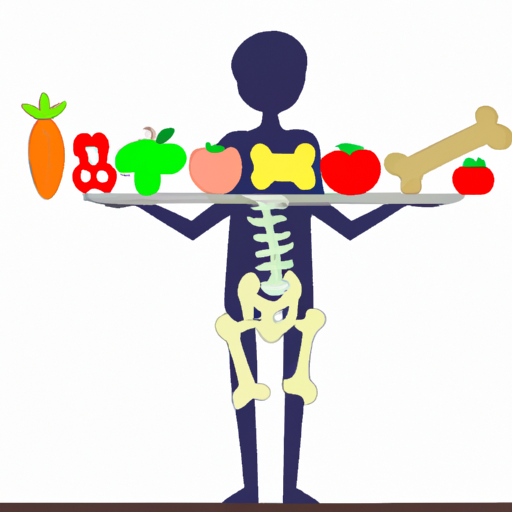- Your cart is empty
- Continue Shopping
Nutrition for Strong Bones: A Comprehensive Guide to Preventing Osteoporosis and Supporting Bone Health

Osteoporosis is a silent but serious condition that affects millions of people worldwide. Characterized by weak and fragile bones, it increases the risk of fractures and can significantly impact a person’s quality of life. While there are various factors that contribute to the development of osteoporosis, diet plays a crucial role in maintaining bone health and preventing its onset. In this article, we will explore the causes, symptoms, and diagnosis of osteoporosis, as well as delve into effective strategies and therapies for treating and preventing this debilitating condition. Additionally, we will provide valuable tips on how to build strong bones through a healthy diet and lifestyle choices. By understanding the importance of nutrition and adopting the right approach, we can support our bone health and reduce the risk of osteoporosis.
1. "Understanding Osteoporosis: Causes, Symptoms, and Diagnosis"
Osteoporosis is a condition characterized by weakened and brittle bones, making individuals more prone to fractures and breaks. Understanding the causes, symptoms, and diagnosis of osteoporosis is crucial for effective prevention and management of this condition.
Causes:
Osteoporosis occurs when the body loses too much bone, produces too little bone, or both. Several factors contribute to the development of this condition. Aging is one of the primary causes, as bone density naturally decreases with age. Hormonal changes, particularly in women during menopause, can also lead to bone loss. Additionally, certain medical conditions, such as hyperthyroidism or celiac disease, can affect bone health. Lifestyle factors, including a sedentary lifestyle, smoking, excessive alcohol consumption, and a poor diet, also contribute to the development of osteoporosis.
Symptoms:
In the early stages, osteoporosis is often asymptomatic, making it difficult to detect without proper screening. However, as the condition progresses, individuals may experience symptoms such as back pain, loss of height over time, stooped posture, and fractures with minimal trauma. Fractures typically occur in the hip, spine, or wrist, and can significantly impact an individual’s quality of life.
Diagnosis:
Diagnosing osteoporosis involves assessing an individual’s bone density and evaluating their risk of fractures. The most common diagnostic tool is a bone mineral density (BMD) test, which measures the bone density at various sites in the body. Dual-energy X-ray absorptiometry (DXA) is the most widely used BMD test and is considered the gold standard for diagnosing osteoporosis. DXA scans are painless and non-invasive, providing accurate information about an individual’s bone health.
In addition to BMD testing, healthcare professionals may also consider an individual’s medical history, physical examination, and laboratory tests to assess the underlying causes of osteoporosis. These tests help identify any secondary causes, such as hormonal imbalances or medical conditions, and guide the treatment plan.
It
2. "Building Strong Bones: Diet and Lifestyle Tips for Optimal Bone Health"
Maintaining strong and healthy bones is crucial for overall well-being, especially as we age. Osteoporosis, a condition characterized by low bone density and increased risk of fractures, affects millions of people worldwide. While there are several factors that contribute to the development of osteoporosis, including genetics and hormonal changes, diet and lifestyle choices play a significant role in supporting bone health and preventing this condition.
To build strong bones and reduce the risk of osteoporosis, it is essential to consume a well-balanced diet rich in nutrients that promote bone health. Calcium, a mineral vital for bone strength, should be a key focus. Dairy products such as milk, cheese, and yogurt are excellent sources of calcium. However, for those who are lactose intolerant or follow a vegan diet, alternative options like fortified plant-based milks, tofu, and leafy greens such as kale and broccoli can provide adequate amounts of calcium.
In addition to calcium, obtaining sufficient amounts of vitamin D is crucial as it aids in the absorption of calcium. Our bodies can produce vitamin D when exposed to sunlight, but it can also be obtained from dietary sources such as fatty fish (salmon, mackerel), egg yolks, and fortified foods like cereals and orange juice. However, if it is challenging to obtain enough vitamin D through sunlight and diet alone, supplementation may be necessary.
Phosphorus and magnesium are two other minerals that contribute to bone health. Foods rich in phosphorus include fish, poultry, nuts, and legumes, while magnesium can be found in leafy greens, whole grains, nuts, and seeds. Including these nutrients in your diet, along with calcium and vitamin D, can help support optimal bone health.
Apart from focusing on specific nutrients, maintaining a healthy diet overall is important for bone health. A diet rich in fruits, vegetables, whole grains, lean proteins, and healthy fats provides a wide range of nutrients necessary for bone health and overall well-being. Avoiding excessive alcohol consumption and reducing the intake of caffeine and sodium can also benefit bone
3. "Treating and Preventing Osteoporosis: Effective Strategies and Therapies"
Osteoporosis is a progressive bone disease that weakens the bones, making them more susceptible to fractures and breaks. It affects millions of people worldwide, particularly women during and after menopause. While there is no cure for osteoporosis, there are several effective strategies and therapies that can help treat and prevent this condition.
One of the primary approaches to managing osteoporosis is through lifestyle modifications, particularly focusing on diet and exercise. Consuming a balanced diet that is rich in calcium, vitamin D, and other essential nutrients is crucial for maintaining bone health. Calcium is the main building block of bones, and inadequate intake can lead to bone loss. Good sources of calcium include dairy products, leafy green vegetables, fortified cereals, and seafood. Additionally, vitamin D helps the body absorb calcium and is naturally obtained from sunlight exposure or through dietary sources like fatty fish, fortified dairy products, and egg yolks.
Regular exercise plays a vital role in improving bone density and strength. Weight-bearing exercises such as walking, jogging, dancing, and resistance training help stimulate bone growth and prevent bone loss. Engaging in these activities for at least 30 minutes most days of the week can significantly reduce the risk of osteoporosis.
In addition to lifestyle modifications, there are various medical treatments available for osteoporosis. The most commonly prescribed medications for this condition are bisphosphonates, which help slow down bone loss and reduce the risk of fractures. These drugs work by inhibiting the cells responsible for breaking down bone tissue. Other medications, such as selective estrogen receptor modulators (SERMs), hormone replacement therapy (HRT), and calcitonin, may also be prescribed in certain cases.
It is essential to note that these medications may have potential side effects, and their usage should be discussed with a healthcare professional. Regular monitoring and follow-up appointments are necessary to evaluate the effectiveness of the treatment and make any necessary adjustments.
Preventing osteoporosis starts from an early age. Building strong bones during childhood and adolescence can significantly reduce the risk of developing osteopor

